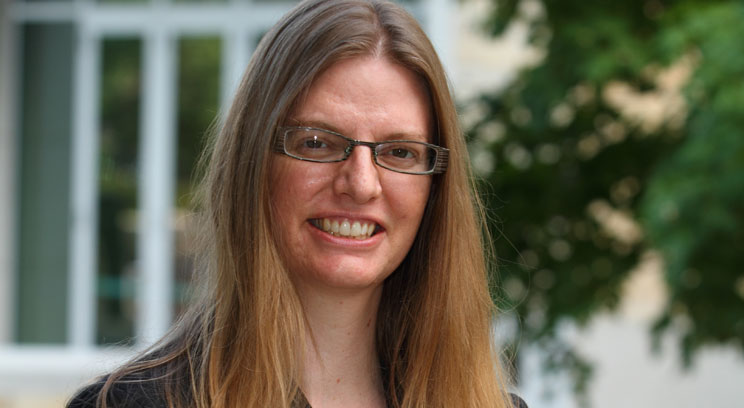The classrooms in Schulze Hall at the Opus College of Business, where Full-time UST MBA students spend countless hours each week learning, collaborating, analyzing, and problem solving, are outfitted with high-backed, black, executive chairs. I have never taken particular note of these chairs, but to first-year UST MBA student Lindsay Young, Ph.D., they represent much more than a functional place to sit during class.
Young is an inaugural fellow of the Applied Business Training program administered by the BioBusiness Alliance of Minnesota, and enrolled in the Full-time MBA program to complement her extensive research in nutrition, biochemistry, and cancer prevention with practical business knowledge. From her unique perspective and years spent in a science-focused classroom, the executive chairs in OCB classrooms embody the professionalism UST faculty and administrators display and expect from students, advance the curriculum’s applied and team-based approach to addressing business concepts and issues, and reinforce the overall brand of the University of St. Thomas. How do you get all of that from a chair?
First year-MBA students are immersed in teamwork, presentations, and branding case studies beginning the first day of Launch, the intensive week-long orientation to the Full-time MBA experience. By week's end, they have completed several assignments; designed and delivered a consulting-based presentation to the dean, faculty, and program administrators; and learned the responsibility and importance of being ambassadors of the UST and OCB brand. Students are treated as and expected to contribute like business professionals worthy of the “executive” chairs they sit in. For Young, this prompted several early observations about her previous and current graduate school experience.
Young recalled that in academia in the sciences, individual contributors are rewarded and highly valued, and team-based work is less common. She shared an article with me from the scientific journal Nature America that highlighted some of the primary differences those from an extensive academic, science-based background experience when moving either to industry or a more business-focused environment. Individualism is first on the list. "Individual project ownership, and the recognition that follows, is the pillar on which careers are made or lost in the academic arena."
At UST, Young noted that the strong focus on teamwork and the holistic success (or failure) of a team was immediately apparent, and a refreshing and engaging approach to solving problems and advancing her own learning. Full-time MBA program teams are comprised of individuals with very diverse professional and academic backgrounds. Young noted that the ability to draw from her team’s high-caliber set of previous experiences to collectively approach a business issue has already proven very valuable, and is something she continues to look forward to over the next twenty months of the program.
For Young, UST’s team-based approach also complements the applied business curriculum through collaborative analysis and discussion about “real world” business issues and topics. This practical, applied approach is another new experience for her. She noted that much of the graduate-level research and learning in the sciences is based on a predominantly theoretical approach, which can be challenging to apply in real world scenarios. Scientific research is often conducted solely “for science’s sake,” or based on intellectual curiosity vs. actual utility. Young has observed that the business concepts she has already been exposed to in the Full-time UST MBA use theory as a foundation, but then go a step further to focus on its utility in addressing problems, issues, or better understanding business environments and markets.
Professors encourage participation and use case studies, experiential learning, and current events as examples to illustrate how business theories are applied in today’s world. From Young’s perspective, this approach makes new concepts easier to remember and synthesize. Nature America’s above-referenced piece further highlighted the importance of using intellectual curiosity developed in academia to ask and research critical questions in science-business industries. A key to success for individuals with a science-focused background is the ability to not only produce quality research or execute a detailed project, but to do so while understanding and considering business constraints such as company finances, overall market conditions, and competition. Young noted that after only a short time as a UST MBA student, the applied approach to learning has allowed her to expand and build upon her existing scientific analysis skills, and view the world and business-at-large through a different lens.
So, back to those executive chairs. Young shared that as a student in the theory-to-practice based classroom who more deeply understands the UST brand and ethical approach to business, sitting in an executive chair makes her actually think and contribute as an executive would – both individually and to her team. For Young, the executive chairs are a visible sign that the Full-time UST MBA program aims to set its students up for success; the seemingly unassuming executive chairs advance the mission, goals, and purpose of the program by creating a professional environment that fosters exchange, knowledge, and skill-development. Twenty-one months from now, Young and her classmates will use such skills and knowledge to make important decisions when sitting in their own boardroom or office chairs, regardless of their pre-MBA background.
From Young’s first impressions of her MBA experience, it is clear that the Applied Business Training program and the BioBusiness Alliance’s partnership with St. Thomas are already yielding a strong ROI. As it turns out, those Schulze classroom executive chairs offer not just a comfortable seat, but an expansive point of view for STEM-background students to learn about the business world.
References:
Acton, G., Gomez-Yafal, A., & Walsh, E. (2012). From academic solos to industrial symphonies. Nature America, 1-3.







